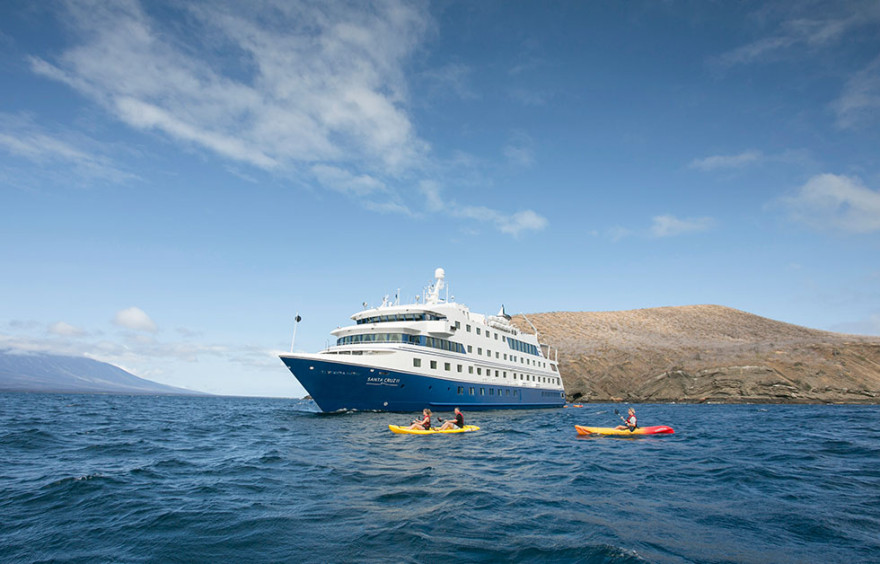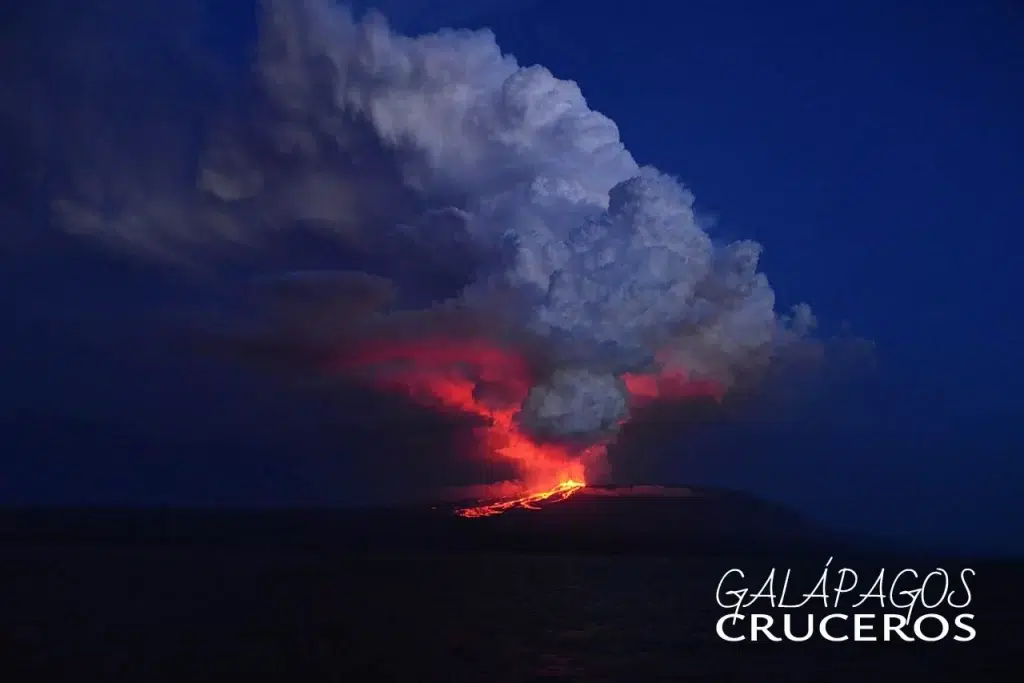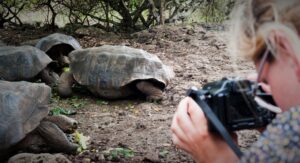South Plaza Island is one of two small crescent-shaped islands, located a few hundred meters off the east coast of Santa Cruz Island Only the southern part can be visited as the northern part of the island is reserved for scientific purposes.
Plaza Sur is one of the smallest but also the richest islands in the archipelago. With only 130 meters (426 feet) in width, it was formed by a tectonic uplift that gave it the shape of an inclined plane. The island’s unusual vegetation and location create an interesting landscape where the fauna and flora of Galapagos are prominently highlighted.
Visit Plaza South Plaza Island aboard a cruise in the Galapagos. Contact us now!

On the other hand, despite its small size, some of the most interesting and exceptional species of the archipelago are found here. It is possible to guarantee the spotting of Land Iguanas which often remain in the shade of cacti. Swallow-tailed gulls often nest on the steep southern cliffs, where they can be seen along with a variety of seabirds. The protected rocky coastline is the main habitat of a large colony of noisy sea lions. The main attraction of Plazas are the land iguanas, sea lions and swallow-tailed gulls. You will also see yellow-tailed mullets, Audubon's hawks, red-billed tropicbirds, frigate birds and brown pelicans gliding over the reef.
Path to the Island
Landing in the channel between Plaza Norte and Plaza Sur, where the island gently slopes down to the water. The approach creates a highly colorful spectacle! The turquoise waters of the channel contrast brilliantly with the black lava of the shores. In some places, dense green algae have grown on the rocks, dotted with bright orange Zayapaz. Further up the coast, a carpet of scarlet ice plants (Sesuvium) serves as a canopy for a forest of bright green cacti. Yellow-gray land iguanas sit underneath, patiently waiting for the prickly pear fruits to fall.
The path gradually follows the slope of the island to the cliff overlooking the southern sea, where swallow-tailed gulls nest, Nazca Boobies and blue-footed boobies stroll among the wind currents. Passing along the cliff top, you will see lots of marine life, including manta rays. Sail to an inlet on the western corner of the island, where a colony of male sea lions, known as a bachelor site, has established itself. The oil from their skin that they leave on the rocks gives them a sheen and shine.
Requirements to enter Plaza Sur Island in Galapagos
The requirements to enter Plaza Sur Island are similar to the requirements to enter the Galapagos Islands. Here is a brief summary for you.
For Ecuadorian travelers:
- ID or Passport: Ecuadorian nationals can enter the Galapagos Islands by presenting their identity card or passport.
- Lodging reservation and/or letter of invitation: Accommodation reservation and/or letter of invitation: A reservation of accommodation in Galapagos may be required as part of the entry requirements. It may also be useful to have a letter of invitation if you are staying in someone's home.
For foreigners:
- Valid passport: Foreigners must present a valid passport when entering Galapagos.
- Tourist Visa: Most foreigners do not need a tourist visa to enter Ecuador, but it is important to check if your nationality requires a visa and, if so, obtain one in advance.
- Migratory Control Card: Upon arrival in the Galapagos, foreign visitors must complete a Migration Control Card, which is usually provided during the flight or upon arrival at the airport.
- Return air ticket: You may be required to present a return air ticket to your country of origin or departure from the Galapagos Islands as part of the entry requirements.
- Accommodation reservation: Similar to nationals, some places may require an accommodation reservation as part of the documents required for entry.
How to get to South Plaza Island?
Getting to South Plaza Island in the Galapagos from Quito or Guayaquil, Ecuador, requires a plane ride and then a boat trip. Here are two routes, one from Quito and one from Guayaquil:
From Quito to South Plaza Island
- Flight to Baltra or San Cristobal: Start by taking a flight from Mariscal Sucre International Airport in Quito to Seymour Airport in Baltra or to San Cristobal Airport. Most flights from Quito make stopovers in Guayaquil or Quito, so you may need to make a stopover before arriving in the Galapagos.
- Transit Control Card Payment: Al llegar a las Islas Galápagos, debes pagar una tarifa de entrada y obtener una Tarjeta de Control de Tránsito en el aeropuerto. Esto es necesario para ingresar al Parque Nacional Galápagos. Conoce aquí los requisitos para entrar a Galápagos.
- Transfer to Puerto Ayora (Santa Cruz Island): If you arrived in Baltra, you will take a short ferry to Santa Cruz Island and then a land transfer to Puerto Ayora, which is the main starting point for tours in the Galapagos.
- Tour to Plaza Sur Island: From Puerto Ayora, you can book a tour to Plaza Sur Island with local operators. These tours typically include boat transportation, a tour guide, and opportunities to explore the island and its unique wildlife.
From Guayaquil to South Plaza Island
- Flight to Baltra or San Cristobal: As from Quito, start by taking a flight from Jose Joaquin de Olmedo International Airport in Guayaquil to Seymour Airport in Baltra or to San Cristobal Airport in the islands.
- Transit Control Card Payment: Upon arrival to the Galapagos Islands, follow the same procedure as described on the route from Quito: pay the entrance fee and obtain the Transit Control Card at the airport.
- Transfer a Puerto Baquerizo Moreno (Isla San Cristóbal): If you arrived to San Cristobal , you will take a land transfer to Puerto Baquerizo Moreno, which is the main city in the island.
- Tour to South Plaza Island: From San Cristobal, you can book a tour to South Plaza Island with local operators. These tours offer the opportunity to explore the island and its unique wildlife.
Weather in South Plaza Island
The climate in South Plaza Island, as in the rest of the Galapagos Islands, is subtropical and is mainly influenced by its equatorial location and ocean currents. Here is some information about the climate in South Plaza Island:
- Temperature: The average annual temperature on South Plaza Island tends to range from 22°C to 28°C (72°F to 82°F). During the warm season, which runs from December to May, temperatures tend to be higher, while the garua season, from June to November, brings slightly cooler temperatures.
- Seasons: As in the rest of the Galapagos, South Plaza Island has two main seasons: the warm season and the garua season (light rainy season). The warm season is drier and sunnier, while the garua season is cooler and wetter.
- Rain: During the garua season, the island may experience light rains and garua, especially in the morning and on the south coast. However, these rains tend to be scarce compared to other parts of the world.
- Winds: Wind is an important characteristic of the climate in the Galapagos. During the garua season, the trade winds from the southeast are stronger, which influences sea conditions and navigation.
- Activities: The choice of the season to visit South Plaza Island will depend on your preferences and activities. The warm season is ideal for diving and snorkeling due to the excellent underwater visibility. On the other hand, the garua season is excellent for bird watching, as many species breed at this time.
Learn about the weather in the Galapagos here .

Flora and Fauna in South Plaza Island
South Plaza Island, one of the islands in the Galapagos archipelago, is a place of great interest for flora and fauna observation. Below, I provide you with information about the characteristic flora and fauna of South Plaza Island:
Flora in South Plaza Island
- Opuntia Cacti: Lava cacti, also known as Opuntia cacti, are one of the most prominent species on the island. These succulent, spiny cacti are an iconic feature of the landscape and can reach significant heights.
- Sesuvium: The coastal vegetation is dominated by Sesuvium, a succulent plant that changes color from green to bright red during the iguana breeding season.
- Scalesia: The genus of trees and shrubs endemic to Galapagos, known as scalesia, is found on South Plaza Island in various shapes and sizes.
- Black Sage Black sage (Lycium sp.) is a plant adapted to the dry conditions of the island and is prized for its silvery foliage and small flowers.

Fauna In South Plaza Island
- Land Iguanas: South Plaza Island is home to a population of marine iguanas (Amblyrhynchus cristatus), a unique species that feeds on seaweed and is endemic to the Galapagos. You can observe them resting on the rocks or swimming in the surrounding waters.
- Sea Lions: On the beaches and rocks of the island, you can find sea lions resting, playing and socializing. They are a common and charismatic sight in the Galapagos.
- Sea Birds South Plaza Island is an important nesting site for seabirds, including blue-footed boobies and red-footed boobies, as well as frigate birds. You can observe their colonies and mating behavior during the right season.
- Land Tortoises: Although the island is not home to land tortoises, you may encounter them in nearby areas during some excursions.
- Aves playeras: The coast of South Plaza Island is an important site for the observation of migratory shorebirds that rest on the beach during their migratory routes.
- Red Crabs: Red crabs (Grapsus grapsus) are a common sight found on the rocks and beaches of South Plaza Island. Their bright red color is quite distinctive.

The South Plaza Island offers a unique wildlife watching experience and an opportunity to explore the unique ecosystem of the Galapagos. Remember that when visiting this island, it is important to follow local regulations and the indications of the tour guides to preserve its beauty and biodiversity.
Activities you can do on Plaza Sur Island
Plaza Sur Island, one of the Galapagos Islands, offers visitors the opportunity to enjoy a variety of unique activities and natural experiences. Here are some activities you can do on Plaza Sur Island:
- Wildlife Observation: Plaza Sur is known for its unique wildlife, including land iguanas, sea lions, and seabirds such as red-footed boobies and Galapagos gulls. Enjoy observing these species in their natural habitat.
- Hiking: Explore the island's trails, which take you through stunning landscapes and allow you to get closer to wildlife. Be sure to follow the guides' instructions to minimize your impact on the environment.
- Snorkeling: The marine life around Plaza Sur is fascinating. Take the opportunity to go snorkeling and explore the underwater world, with the chance to swim alongside colorful fish, rays, and maybe even sharks.
- Nature Photography: The island offers unique natural landscapes that are ideal for photography. Capture the beauty of the scenery, flora, and fauna while ensuring compliance with conservation regulations.
- Interaction with Sea Lions: Plaza Sur is home to a colony of sea lions. You can observe their behavior from a safe distance, but it is important not to disturb their natural habitat
- Learning About Conservation: Many excursions to Plaza Sur Island include the opportunity to learn about conservation efforts in the Galapagos and the importance of preserving this fragile ecosystem.





